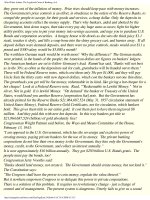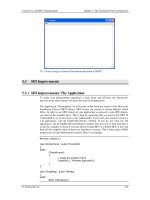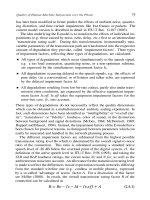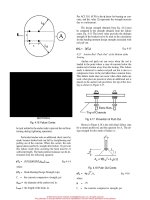Standard Methods for the Examination of Water and Wastewater P3
Bạn đang xem bản rút gọn của tài liệu. Xem và tải ngay bản đầy đủ của tài liệu tại đây (289.03 KB, 72 trang )
Standard Methods for the Examination of Water and Wastewater
© Copyright 1999 by American Public Health Association, American Water Works Association, Water Environment Federation
10900 C. Key for Identification of Freshwater Algae Common in Water Supplies and Polluted Waters*#(1)
(Plate 1A, Plate 1B, Plate 28– Plate 35)
Beginning with 1a and 1b, choose one of the two contrasting statements and follow this procedure with the ‘‘a’’ and ‘‘b’’
statements of the number given at the end of the chosen statement. Continue until the name of the alga is given instead of another key
number.
Statement
Refer to
Couplet
No.
1a. Plastid (separate color body) absent; complete protoplast pigmented; generally
blue-green; iodine starch test† negative (cyanobacteria, blue-green algae)
4
1b. Plastid or plastids present; parts of protoplast free of some or all pigments;
generally green, brown, red, etc., but not blue-green; iodine starch test† positive
or negative
2
2a. Cell wall permanently rigid (never showing evidence of collapse), and with
regular pattern of fine markings (striations, etc.); plastids brown to green;
iodine starch test† negative; flagella absent; wall of two essentially similar
halves, one placed over the other as a cover (diatoms)
29
2b. Cell wall, if present, capable of sagging, wrinkling, bulging, or rigidity,
depending on existing turgor pressure of cell protoplast; regular pattern of
fine markings on wall generally absent; plastids green, red, brown, etc.;
iodine starch test† positive or negative; flagella present or absent; cell wall
continuous and generally not of two parts
3
3a. Cell or colony motile; flagella present (often not readily visible); anterior and
posterior ends of cell different from one another in contents and often in shape
(flagellate algae)
51
Standard Methods for the Examination of Water and Wastewater
© Copyright 1999 by American Public Health Association, American Water Works Association, Water Environment Federation
Statement
Refer to
Couplet
No.
3b. Nonmotile; true flagella absent; ends of cells often not differentiated (green algae
and associated forms)
77
1. Cyanobacteria (Blue-Green Algae)
4a. Cells in filaments (or much elongated to form a thread) 5
4b. Cells not in (or as) filaments 23
5a. Heterocysts present 6
5b. Heterocysts absent 14
6a. Heterocyst located at one end of filament 7
6b. Heterocysts at various locations in filament 9
7a. Filaments radially arranged in a gelatinous bead Rivularia
7b. Filaments isolated or irregularly grouped 8
8a. Filament gradually narrowed to one end Calothrix
8b. Filament not gradually narrowed to one end Cylindrospermu
m
9a. Filament unbranched 10
9b. Filament with occasional (false) branches 13
10a. Crosswalls in filament much closer together than width of
filament
Nodularia
10b. Crosswalls in filament at least as far apart as width of filament 11
Standard Methods for the Examination of Water and Wastewater
© Copyright 1999 by American Public Health Association, American Water Works Association, Water Environment Federation
Statement
Refer to
Couplet
No.
11a. Filaments normally in tight parallel clusters; heterocysts and
spores cylindric to long oval in shape.
A
phanizomenon
11b. Filaments not in tight parallel clusters; heterocysts and spores often round to oval12
12a. Filaments in a common gelatinous mass Nostoc
12b. Filaments not in a common gelatinous mass
A
nabaena
13a. False branches in pairs Scytonema
13b. False branches, single Tolypothrix
14a. Filament or elongated cell attached at one end, with one
or more round cells (spores) at the other
Chamaesiphon
14b. Filament generally not attached at one end; no terminal spores present 15
15a. Filament with regular spiral form throughout 16
15b. Filament not spiral, or with spiral form limited to a portion of filament 17
16a. Filament septate
A
rthrospira
16b. Filament nonseptate Spirulina
17a.
Filament very narrow, only 0.5 to 2.0 µm wide
Schizothrix
17b.
Filament 3 to 95 µm wide
18
18a. Filaments loosely aggregated or not in clusters 19
18b. Filaments tightly aggregated and surrounded by a common gelatinous
secretion that may be invisible
22
19a. Filament surrounded by wall-like sheath that frequently extends beyond the ends
of the filament of cells; filament generally withoutmovement
20
19b. Filament not surrounded by a wall-like sheath; filament may show movement 21
Standard Methods for the Examination of Water and Wastewater
© Copyright 1999 by American Public Health Association, American Water Works Association, Water Environment Federation
Statement
Refer to
Couplet
No.
20a. Cells separated from one another by a space Johannesbaptisti
a
20b. Cells in contact with adjacent cells Lyngbya
21a. All filaments short, with less than 20 cells; one or both ends of
filament sharply pointed
Raphidiopsis
21b. Filaments long, with more than 20 cells; filaments commonly
without sharp-pointed ends
Oscillatoria
22a. Filaments arranged in a tight, essentially parallel bundle Microcoleus
22b. Filaments arranged in irregular fashion, often forming a
mat
Phormidium
23a. Cells in a regular pattern of parallel rows, forming a plate Merismopedia
23b. Cells not regularly arranged to form a plate 24
24a. Cells regularly arranged near surface of a spherical gelatinous bead 25
24b. Gelatinous bead, if present, not spherical 26
25a. Cells ovate to heart-shaped, connected to center of bead by
colorless stalks
Gomphosphaeri
a
25b. Cells round, without gelatinous stalks Coelosphaerium
type
26a. Cells cylindric-oval
A
phanothece
26b. Cells spherical 27
27a. Two or more distinct layers of gelatinous sheath around each
cell or cell cluster
Gloeocapsa
Standard Methods for the Examination of Water and Wastewater
© Copyright 1999 by American Public Health Association, American Water Works Association, Water Environment Federation
Statement
Refer to
Couplet
No.
27b. Gelatinous sheath around cells not distinctly layered 28
28a. Cells isolated or in colonies of 2 to 32 cells Chroococcus
28b. Cells in colonies composed of many cells
A
nacysti
s
(Microcystis,
Polycystis)
2. Diatoms
29a. Front (valve) view circular in outline; markings radial in arrangement; cells may
form a filament (centric diatoms)
30
29b. Front (valve) view elongate, not circular; transverse markings in one or two
longitudinal rows; cells, if grouped, not forming a filament (pennate diatoms)
32
30a. Cells in persistent filaments with valve faces in contact;
therefore, cells commonly seen in side (girdle) view
Melosira
30b. Cells isolated or in fragile filaments, often seen in front (valve) view 31
31a. Radial markings (striations), in valve view, extending from
center to margin; short spines often present around margin
(valve view)
Stephanodiscus
31b. Area of prominent radial markings, in valve view, limited to
approximately outer half of circle, marginal spines generally
absent
Cyclotella
32a. Cell longitudinally symmetrical in valve view 33
Standard Methods for the Examination of Water and Wastewater
© Copyright 1999 by American Public Health Association, American Water Works Association, Water Environment Federation
Statement
Refer to
Couplet
No.
32b. Cell longitudinally unsymmetrical (two sides unequal in shape), at least in
valve view
49
33a. Raphe at or near the edge of the valve 34
33b. Raphe or pseudoraphe median or submedian 35
34a. Marginal, keeled raphe areas lie opposite one another
on the two valves
Hantzschia
34b. Marginal, keeled raphe areas lie diagonal to one another
on the two valves
Nitzschia
35a. Cell transversely symmetrical in valve view 36
35b. Cell transversely unsymmetrical (two ends unequal in shape or size), at least in
valve view
44
36a. Cell round-oval in valve view, not more than twice as
long as it is wide
Cocconeis
36b. Cell elongate, more than twice as long as it is wide 37
37a. Cell flat (girdle face wide, valve face narrow) Tabellaria
37b. Girdle and valve faces about equal in width 38
38a. Cell with several markings (septa) extending without
interruption across the valve face; no marginal line of
pores present
Diatoma
38b. Cross-markings (striations or costae) on valve surface, interrupted by
either longitudinal space (pseudoraphe), or line (raphe), or line of pores
(carinal dots)
39
Standard Methods for the Examination of Water and Wastewater
© Copyright 1999 by American Public Health Association, American Water Works Association, Water Environment Federation
Statement
Refer to
Couplet
No.
39a. Cells attached side by side to form a ribbon of several to many
cells
Fragilaria
39b. Cells isolated or in pairs 40
40a. Cell narrow, linear, often narrowed to both ends; true
raphe absent
Synedra
40b. Cell commonly ‘‘boat-shape’’ in valve view; true raphe present 41
41a. Cell longitudinally unsymmetrical in girdle view; sometimes with
attachment stalk
A
chnanthe
s
41b. Cell symmetrical in girdle as well as valve view; generally not attached 42
42a. Area without striations extending as a transverse belt
around middle of cell
Stauroneis
42b. No continuous clear belt around middle of cell 43
43a. Cell with coarse transverse markings (costae), which appear as
solid lines even under high magnification
Pinnularia
43b. Cell with fine transverse markings (striae), which appear as
lines of dots under high magnification
Navicula
44a. Cells attached together at one end only to form radiating
colony
A
sterionella
44b. Cell not forming a loose radiating colony 45
45a. Cells in fan-shaped colonies Meridion
45b. Cells isolated or in pairs 46
46a. Prominent wall markings in addition to striations present
j
ust below lateral margins on valve surface of cell
Surirella
Standard Methods for the Examination of Water and Wastewater
© Copyright 1999 by American Public Health Association, American Water Works Association, Water Environment Federation
Statement
Refer to
Couplet
No.
46b. Wall markings along sides of valve limited to striations 47
47a. Cell elongate, sides almost parallel except for terminal knobs
A
sterionella
47b. Sides of cell converging toward one end 48
48a. Cells bent in girdle view Rhoicosphenia
48b. Cells straight in girdle view Gomphonema
49a. Valves with transverse septa or costae Epithemia
49b. Valves with no transverse septa or costae 50
50a. Raphe located almost through center of valve Cymbella
50b. Raphe excentric, near concave edge of valve
A
mphora
3. Flagellate Algae
51a. Cell in a loose, rigid conical sac (lorica); isolated or in a
branching colony
Dinobryon
51b. Case or sac, if present, not conical; colony, if present, not branching 52
52a. Cells isolated or in pairs 53
52b. Cells in a colony of four or more cells 71
53a. Prominent transverse groove encircles cell 54
53b. Cell without transverse groove 56
54a. Cell with prominent rigid projections, one forward and
two or three on posterior end
Ceratium
Standard Methods for the Examination of Water and Wastewater
© Copyright 1999 by American Public Health Association, American Water Works Association, Water Environment Federation
Statement
Refer to
Couplet
No.
54b. Cell without several rigid polar projections 55
55a. Portions above and below transverse groove about equal Peridinium
55b. Front portion distinctly larger than posterior portion Massartia
56a. Cell with long bristles extending from surface plates Mallomonas
56b. Cell without bristles and surface plates 57
57a. Cell protoplast enclosed in loose, rigid covering (lorica) 58
57b. Cell with tight membrane or wall but no loose, rigid covering 60
58a. Lorica flattened; cell with two flagella Phacotus
58b. Lorica not flattened; cell with one flagellum 59
59a. Lorica often opaque, generally dark brown to red; plastid green Trachelomonas
59b. Lorica often transparent, colorless to light brown; plastid light
brown
Chrysococcus
60a. Plastids brown to red to olive or blue-green 61
60b. Plastids grass green 64
61a. Plastids blue-green to blue Chroomonas
61b. Plastids brown to red to olive green 62
62a. Plastid brown; one or two flagella 63
62b. Plastids red, red-brown, or olive green; two flagella Rhodomonas
63a. Anterior end of cell oblique; two flagella Cryptomonas
63b. Anterior end of cell rounded or pointed; one flagellum Chromulina
64a. Cell with colorless rectangular wing Pteromonas
Standard Methods for the Examination of Water and Wastewater
© Copyright 1999 by American Public Health Association, American Water Works Association, Water Environment Federation
Statement
Refer to
Couplet
No.
64b. No wing extending from cell 65
65a. Cells flattened; margin rigid Phacus
65b. Cell not flattened; margin rigid or flexible 66
66a. Pyrenoid present in the single plastid; no paramylon; margin not flexible;
two or more flagella per cell
67
66b. Pyrenoid absent; paramylon present; several plastids per cell; margin
flexible or rigid; one flagellum per cell
70
67a. Cells fusiform (tapering at each end) Chlorogonium
67b. Cells not fusiform, generally almost spherical 68
68a. Plastids numerous Vacuolaria
68b. Plastids few, commonly one 69
69a. Two flagella per cell Chlamydomonas
69b. Four flagella per cell Carteria
70a. Cell flexible in form; paramylon a capsule or disk; cell
elongate
Euglena
70b. Cell rigid in form; paramylon ring-shaped; cell almost
spherical
Lepocinclis
71a. Plastids brown 72
71b. Plastids green 73
72a. Cells in contact with one another Synura
72b. Cells separated from one another by space Uroglenopsis
73a. Colony flat, one cell thick Gonium
Standard Methods for the Examination of Water and Wastewater
© Copyright 1999 by American Public Health Association, American Water Works Association, Water Environment Federation
Statement
Refer to
Couplet
No.
73b. Colony rounded, more than one cell thick 74
74a. Cells in contact with one another 75
74b. Cells separated from one another by space 76
75a. Cells radially arranged Pandorina
75b. Cells all facing one direction Pyrobotrys
(Chlamydobotrys
)
76a. Cells more than 400 per colony Volvox
76b. Cells less than 75 per colony Eudorina
4. Green Algae and Associated Forms
77a. Cells jointed together to form a net Hydrodictyon
77b. Cells not forming a net 78
78a. Cells attached side by side to form a plate or ribbon one
cell wide and thick; number of cells commonly two, four,
or eight
Scenedesmus
78b. Cells not attached side by side 79
79a. Cells isolated or in nonfilamentous or nontubular thalli 80
79b. Cells in filaments or other tubular or threadlike thalli 111
80a. Cells isolated and narrowest at the center because of incomplete fissure
(desmids)
81
Standard Methods for the Examination of Water and Wastewater
© Copyright 1999 by American Public Health Association, American Water Works Association, Water Environment Federation
Statement
Refer to
Couplet
No.
80b. Cells isolated or in clusters but without central fissure 84
81a. Each half of cell with three spinelike or pointed knobular
extensions
Staurastrum
81b. Cell margin with no such extensions 82
82a. Semicells with a median incision or depression 83
82b. Semicells with no median incision or depression Cosmarium
83a. Margin with rounded lobes Euastrum
83b. Margin with sharp-pointed teeth Micrasterias
84a. Cells elongate 85
84b. Cells round to oval or angular 92
85a. Cell radiating from a central point
A
ctinastrum
85b. Cells isolated or in irregular clusters 86
86a. Cells with terminal spines Schroederia
86b. Cells without terminal spines 87
87a. Cells with colorless attachment area at one end Characium
87b. No attachment area at one end of cell 88
88a. Plastids two per cell; unpigmented area across center of
cell
Closterium
88b. Cell with plastid that continues across the center 89
89a. Cell 5 to 10 times as long as it is broad 90
89b. Cell 2 to 4 times as long as it is broad 91
Standard Methods for the Examination of Water and Wastewater
© Copyright 1999 by American Public Health Association, American Water Works Association, Water Environment Federation
Statement
Refer to
Couplet
No.
90a. Pyrenoid absent, or one per cell
A
nkistrodesmu
s
90b. Pyrenoids several per cell Closteriopsis
91a. Cells semicircular; cell ends pointed but with no terminal spines Selenastrum
91b. Cells arcuate but less than semicircular; cell ends pointed and
each with a short spine
Closteridium
92a. Cells regularly arranged in a tight, flat colony Pediastrum
92b. Cells not in a tight, flat regular colony 93
93a. Cells angular 94
93b. Cells round to oval 95
94a. Two or more spines at each angle Polyedriopsis
94b. Spines none or less than two at each angle Tetraedron
95a. Cells with long, sharp spines 96
95b. Long, sharp spines absent 99
96a. Cells round 97
96b. Cells oval 98
97a. Cells isolated Golenkinia
97b. Cells in colonies Micractinium
98a. Each cell end has one spine Diacanthos
98b. Each cell end has more than one spine Chodatella
99a. Colony of definite regular form, round to oval 100
99b. Colony, if present, not a definite oval or sphere; or cells may be isolated 104
Standard Methods for the Examination of Water and Wastewater
© Copyright 1999 by American Public Health Association, American Water Works Association, Water Environment Federation
Statement
Refer to
Couplet
No.
100a. Colony a tight sphere of cells 101
100b. Colony a loose sphere of cells enclosed by a common membrane 102
101a. Sphere solid, slightly irregular, no connecting processes
between cells
Planktosphaeria
101b. Sphere hollow, regular; short connecting processes between
cells
Coelastrum
102a. Cells round 103
102b. Cells oval Oocystis
103a. Cells connected to center of colony by branching stalk Dictyosphaerium
103b. No stalk connecting cells Sphaerocystis
104a. Oval cells, enclosed in a somewhat spherical, often
orange-colored matrix
Botryococcus
104b. Cells round, isolated or in colorless matrix 105
105a. Adjoining cells with straight, flat walls between their protoplasts 106
105b. Adjoining cells with rounded walls between their protoplasts 107
106a. Cells embedded in a common gelatinous matrix Palmella
106b. No matrix or sheath outside of cell walls Phytoconis
(Protococcus)
107a. Cells loosely arranged in a large gelatinous matrix Tetraspora
107b. Cells isolated or tightly grouped in a small colony 108
108a. Cells located inside of protozoa Zoochlorella
108b. Cells not inside of protozoa 109
Standard Methods for the Examination of Water and Wastewater
© Copyright 1999 by American Public Health Association, American Water Works Association, Water Environment Federation
Statement
Refer to
Couplet
No.
109a. Plastid filling 2/3 or less of cell 110
109b. Plastid filling ¾ or more of cell Chlorococcum
110a.
Cell diameter 2 µm or less; reproduction by cell division
Nannochloris
110b.
Cell diameter 2.5 µm or more; reproduction by internal
spores
Chlorella
111a. Cells attached end to end in an unbranched filament 112
111b. Thallus branched, or more than one cell wide 119
112a. Plastids in form of one or more marginal spiral ribbons Spirogyra
112b. Plastids not in form of spiral ribbons 113
113a. Filaments, when breaking, separating through middle of cells 114
113b. Filaments, when breaking, separating irregularly or at ends of cells 115
114a. Starch test positive; cell margin straight; one plastid,
granular
Microspora
114b. Starch test negative; cell margin slightly bulging; several
plastids
Tribonema
115a. Marginal indentations between cells Desmidium
115b. No marginal indentations between cells 116
116a. Plastids, two per cell Zygnema
116b. Plastid, one per cell (sometimes appearing numerous) 117
117a. Some cells with walls having transverse wrinkles near one end;
plastid an irregular net
Oedogonium
117b. No apical wrinkles in wall; plastid not porous 118
Standard Methods for the Examination of Water and Wastewater
© Copyright 1999 by American Public Health Association, American Water Works Association, Water Environment Federation
Statement
Refer to
Couplet
No.
118a. Plastid a flat or twisted axial ribbon Mougeotia
118b. Plastid an arcuate marginal band Ulothrix
119a. Thallus a flat plate of cells Hildenbrandia
119b. Thallus otherwise 120
120a. Thallus a long tube without crosswalls Vaucheria
120b. Thallus otherwise 121
121a. Thallus a leathery strand with regularly spaced swellings and a
continuous surface membrane of cells
Lemanea
121b. Thallus otherwise 122
122a. Filament unbranched Schizomeris
122b. Filament branched 123
123a. Branches in whorls (clusters) 124
123b. Branches single or in pairs 126
124a. Thallus embedded in gelatinous matrix Batrachospermu
m
124b. Thallus not embedded in gelatinous matrix 125
125a. Main filament one cell thick Nitella
125b. Main filament three cells thick Chara
126a. Most of filament surrounded by a layer of cells Compsopogon
126b. Filament not surrounded by a layer of cells 127
127a. End cell of branches with a rounded or blunt-pointed tip 128
Standard Methods for the Examination of Water and Wastewater
© Copyright 1999 by American Public Health Association, American Water Works Association, Water Environment Federation
Statement
Refer to
Couplet
No.
127b. End cell of branches with a sharp-pointed tip 130
128a. Plastids green; starch test positive 129
128b. Plastids red; starch test negative
A
udouinella
129a. Some cells dense, swollen, dark green (spores); other cells light
green, cylindric
Pithophora
129b. All cells essentially alike, light to medium green, cylindric Cladophora
130a. Filaments embedded in gelatinous matrix 131
130b. Filaments not embedded in gelatinous matrix 132
131a. Cells of main filament much wider than even the basal cells of
branches
Draparnaldia
131b. No abrupt change in width of cells from main filament to
branches
Chaetophora
132a. Branches very short, with no cross-walls Rhizoclonium
132b. Branches long, with cross-walls 133
133a. Branches ending in an abrupt spine having a bulbous base Bulbochaete
133b. Branches gradually reduced in width, ending in a long pointed
cell, with or without color
Stigeoclonium
10900 D. Index to Illustrations
Standard Methods for the Examination of Water and Wastewater
© Copyright 1999 by American Public Health Association, American Water Works Association, Water Environment Federation
10900 D. Index to Illustrations
Organism Plate
Ablabesmyia 16
Acanthamoeba 5A
Achlya 26
Achnanthes 1B, 31
Acorus 3C
Acroneuria 13
Actinastrum 32
Actinomycetes 26
Actinophrys 5A
Aedes 16
Agardhiella 35
Agnatha 24
Alderflies 15
Algae, brown 2A
Algae, green 1A, 1B, 2A
Algae, marine 2A, 2B
Algae, red 2B
Alona 11
Alternaria 27
Ambystoma 25
Ammicolidae 19
Amoebas (Protozoa) 5A, 5B
Standard Methods for the Examination of Water and Wastewater
© Copyright 1999 by American Public Health Association, American Water Works Association, Water Environment Federation
Organism Plate
Amoeba sp. 5A, 5B
Amphibians 25
Amphidinium 35
Amphiodia 23
Amphipoda 12
Anabaena 28, 29, 30
Anacystis 28
Anatanis 12
Ancylidae 19
Anisonema 4B
Ankistrodesmus 1A, 31, 34
Annelids 9, 10
Anodonta 21
Anthophysa 5B
Anthopleura 7
Antocha 16
Aphanizomenon 1A, 28
Aphanotheca 31
Apple snail 19
Arachnoidea 22
Arcella 5B
Arthropods 11, 12, 13, 14, 15, 16, 17, 18, 22
Arthrospira 30
Standard Methods for the Examination of Water and Wastewater
© Copyright 1999 by American Public Health Association, American Water Works Association, Water Environment Federation
Organism Plate
Asellus 12
Asiatic clam 21
Aspidisca 6
Astasia 4B
Asterias 23
Asterionella 28, 29, 35
Astropecten 23
Audouinella 33
Azolla 3A
Bacillus 26
Backswimmer 18
Bacteria 26
Baetis 13
Balanus 11
Barnacle 11
Basket snail 20
Batrachospermum 33
Beetles 17
Beggiatoa 26
Belostomidae 18
Berosus 17
Biddulphia 1B
Bithynia 19
Standard Methods for the Examination of Water and Wastewater
© Copyright 1999 by American Public Health Association, American Water Works Association, Water Environment Federation
Organism Plate
Bivalves 21
Blackfly 16
Blowfly 16
Blue crab 12
Blue mussel 21
Bodo 4B
Bosmina 11
Botrydium 1B
Botryococcus 32
Brachionus 8
Brachiopoda 22
Brittle star 23
Bryozoa 22
Bubble snail 20
Bugs, true 18
Bugula 22
Bulbochaete 33
Bulla 20
Bull whip 2A
Busycon 20
Caddisflies 15
Callianassa 12
Callinectes 12
Standard Methods for the Examination of Water and Wastewater
© Copyright 1999 by American Public Health Association, American Water Works Association, Water Environment Federation
Organism Plate
Calothrix 31
Cambarus 12
Campeloma 19
Cancer 12
Capitella 10
Capitellids 10
Carteria 30
Cartilage fish 24
Cattail 3C
Caudata 25
Cephalopoda 20
Ceratium 28
Ceratophyllum 3B
>Cercomonas 4B
Cerithidea 20
Chaetoceros 35
Chaetomorpha 35
Chaetophora 33
Chaetopterid 10
Chaetopterus 10
Chamaesiphon 31
Champia 2B
Chaoborus 16
Standard Methods for the Examination of Water and Wastewater
© Copyright 1999 by American Public Health Association, American Water Works Association, Water Environment Federation
Organism Plate
Chara 33
Chauliodes 15
Chironomidae 16
Chironomus 16
Chitons 20
Chlamydomonas 30, 34
Chloramoeba 4A
Chlorella 29, 30
Chlorococcum 30
Chlorogonium 30
Chlorophyta 1A, 1B, 2A
Chodatella 34
Chondrichthys 24
Chordata 24, 25
Chromodoris 20
Chromulina 4A, 31, 34
Chroococcus 29
Chroomonas 34
Chrysococcus 31
Chrysophyta 1B
Ciliates (Protozoa) 6
Cirripedia 11
Cladocerans 11
Standard Methods for the Examination of Water and Wastewater
© Copyright 1999 by American Public Health Association, American Water Works Association, Water Environment Federation
Organism Plate
Cladophora 31, 33
Cladosporium 27
Clams 21
Closteriopsis 34
Closterium 29, 34
Cnidaria 7
Cocconeis 1B, 31
Codium 2A, 35
Coelastrum 32
Coelenterates 7
Coelosphaerium 28
Coleoptera 17
Collembola 22
Colpoda 6
Compsopogon 33
Coontail 3B
Copepod 11
Corallina 2B
Corbicula 21
Corixidae 18
Corydalus 15
Coscinodiscus 1B
Cosmarium 34
Standard Methods for the Examination of Water and Wastewater
© Copyright 1999 by American Public Health Association, American Water Works Association, Water Environment Federation
Organism Plate
Crabs 12
Cranefly 16
Craspedascusta 7
Crassostrea 21
Crawdad 12
Crayfish 12
Crisulipora 22
Crucigenia 1A
Crustaceans 11, 12
Cryptomonas 4A, 34
Culex 16
Culicidae 16
Cumacea 12
Cyanobacteria 1A
Cyanophyta 1A
Cybister 17
Cyclotella 1B, 29, 31
Cylindrospermum 32
Cymbella 29, 33
Damselflies 14
Daphnia 11
Dasyatis 24
Decapoda 12









